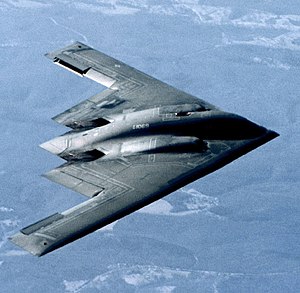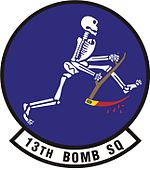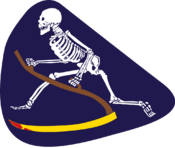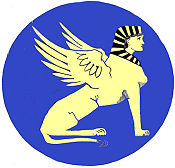| 13th Bomb Squadron | |
|---|---|
 B-2 Spirit of the 509th Operations Group | |
| Active |
June 14, 1917-1919 1936-present |
| Country |
|
| Branch |
|
| Type | Squadron |
| Role | Bombardment |
| Part of | Air Force Global Strike Command |
| Garrison/HQ | Whiteman Air Force Base, Missouri |
| Nickname(s) | The Devil's Own Grim Reapers |
| Motto(s) | Fear the Reaper |
| Colors | Red and black |
| Mascot(s) | Oscar |
| Anniversaries | June 14 |
| Tail Code | "WM" |
| Engagements |
World War I World War II Korean War Vietnam War Operation Allied Force Operation Iraqi Freedom |
| Decorations |
|
| Commanders | |
| Current commander | Lieutenant Colonel Jeffrey T. Schreiner |
| Notable commanders |
Captain Charles Biddle Lieutenant Colonel Rob Fortney Lieutenant Colonel Robert McCormick Lieutenant Colonel Thomas Bussiere |
| Insignia | |
| 13th Bomb Squadron emblem |
 |
The 13th Bomb Squadron (13 BS) is a squadron of the United States Air Force. It is assigned to the 509th Operations Group, Air Force Global Strike Command, stationed at Whiteman Air Force Base, Missouri. The squadron is equipped with the B-2 Spirit Stealth Bomber.[1]
The 13 BS is one of the oldest units in the United States Air Force, first being organized as the 13th Aero Squadron on 14 June 1917 at Kelly Field, Texas. The squadron deployed to France and fought on the Western Front during World War I as a pursuit squadron. The unit was demobilized after the war in 1919.[2] On 16 October 1936, the squadron was consolidated with the 104th Aero Squadron, which was organized on 25 August 1917, another AEF combat squadron on the Western Front.[3] Re-organized in 1921 as part of the permanent United States Army Air Service, the squadron became part of Fifth Air Force in the Pacific Theater of Operations (PTO) of World War II flying B-25 Mitchell medium bombers. During the Cold War, it fought in the Korean War and Vietnam War as a B-57 Canberra tactical bomber squadron.[4]
History[]
The 13th Bomb Squadron traces its origins to two World War I Air Service, United States Army squadrons.
World War I[]
- see 13th Aero Squadron and 104th Aero Squadron for an expanded World War I history.
The 13th Aero Squadron was formed at Kelly Field, Texas, on 14 June 1917.

13th Aero Squadron - SPAD XIII, Souilly Aerodrome, France. 1918
The “Devil’s Own Grim Reapers” as they came to be known was a Pursuit (Fighter) squadron on the Western Front in France during 1918, flying the French SPAD XIII. The 13th claimed several "aces" from this period of its history: Charles J Biddle, Murray K Guthrie, Frank K Hays, John J Seerly, and William H Stovall. Major Carl Spaatz. It returned to the United States in March 1919 when t was demobilized. It remained inactive until it was reconstituted in 1936.[5]
The 104th Aero Squadron was organized on 25 August 1917 also at Kelly Field. As a Corps Observation (Reconnaissance) Squadron flying the French Salmson 2A2 observation aircraft, the 104th flew reconnaissance, directed Allied artillery fire and pinpointed troop movements on the Western Front. The demand for artillery fire adjustments through aerial observation was constant in spite of difficulties encountered in air-to-ground communications. It was largely due to the photos made by aerial reconnaissance that the Allied infantry knew where it was advancing. It returned to the United States in April 1919 and became part of the permanent United States Army Air Service in 1921.[5]
Inter-War period[]
After its arrival at Roosevelt Field, Long Island, the 104th Aero Squadron demobilized and most of its men returned to civilian life. In May 1919, the squadron was reassigned to neighboring Mitchell Field; the squadron was down to one officer and one enlisted man and was carried by the Air Service as an administrative, unmanned unit.[6]
About 15 May, the 104th moved to Fort Bliss, Texas, and during June to Kelly Field, Texas, still manned in name only. On 25 May 1919 it was re-designated as the 104th Surveillance Squadron, and assigned to the Army Surveillance Group on 1 July along with the 8th, 12th, 13th and 90th Aero Squadrons. During August 1919, nearly 200 men from Mitchell Field were moved to Kelly Field to bring the squadron up to strength. The 104th quickly adapted to peacetime soldiering in the nation's infant air organization It was also equipped with new Dayton-Wright DH-4 aircraft, surplus from the World War.[6][7]
Mexican Border patrol[]
- see also: United States Army Border Air Patrol
The mission of the Army Surveillance Group (ASG) was to carry out observation overflights along the Mexican Border. During this period, Mexico was enduring a period of revolution and unrest, which led to border violations and the deaths of American citizens. After being manned and equipped, in November 1919 the squadron split into three flights: Headquarters Flight and Flight A went to Fort Bliss, Texas, while Flight B deployed to Marfa Field, Texas. From 10 September to 4 November, Flight B was located at Post Field, Oklahoma, but it returned to Marfa Field on 17 November 1920, and remained there until June 1921 flying observation flights along the Big Bend area of the Texas/Mexico border.[6][7]
13th Squadron (Attack)[]

13th Attack Squadron Curtiss A-3B.
On 14 March 1921 with the establishment of the permanent Army Air Service, the 104th Surveillance Squadron was re-designed as the 13th Squadron (Attack). In May the border patrol flights were ended and all of the flights were ordered to participate in maneuvers at Langley Field, Virginia. On 2 July the squadron was re-assembled at Kelly Field and on 25 January 1923 the squadron was re-designated the 13th Attack Squadron.[5][6] The new mission of the squadron was to conduct a series of suitability tests of new types of aircraft. Initially tested was Dayton-Wright XB-1A, an observation plane to be used for photography, bombardment and liaison work.[5][6] The next aircraft was the GAX (GA-l), a ground attack triplane. These tests were conducted to determine the capability of aircraft under hard service incurred during long cross-country flights. All squadron officers and enlisted personnel attended classes to learn everything they could about the aircraft.[6]
In 1923, the 13th Attack Squadron returned to the Dayton-Wright DH-4 and performed aerial demonstrations, formation flying, and normal training. Due to funding reductions, the squadron was inactivated on 27 June 1924.[6]
Reserve status and re-activation[]

Curtiss A-8 Shrike ground-attack aircraft No.60 of the 13th Attack Squadron, 1931
After its inactivation from the active forces, the 13th was designated an Active Associate reserve squadron. Remaining as the 13th Attack Squadron, it was allotted to the VIII Corps Area on 28 February 1927. Organized about May 1928 with Organized Reserve personnel as a Regular Army Inactive (RAI) unit. Conducted summer training at Fort Crockett, with units of the 3d Attack Group.[8]
Returned to active status on 1 November 1929, the 13th Attack Squadron again joined the 3d Attack Group at Langley Field, Virginia. Two weeks later the squadron moved to Fort Crockett, Texas. From 1929 to 1934, the squadron flew the Curtiss A-3 aircraft, and then converted to newer A-12s. In February 1935, the 13th moved to Barksdale Field, Louisiana. On 16 October 1936, the War Department reconstituted the World War I 13th Aero Squadron and consolidated it with the 13th Attack Squadron, forming a single squadron with two separate origins, thus perpetuating the history and traditions of both. The 13th Attack Squadron designation was retained for the consolidated unit.[1][6]
Also in 1936, the squadron received the Northrop A-17 ground attack aircraft. It continued flying A-17s through 1939. On 15 September 1939 the squadron became the 13th Bombardment Squadron (Light), while its parent became the 3d Bombardment Group (Light). Douglas B-18 Bolo medium bombers were gained about this same time, but some Martin B-12s were also flown in the 1939-1941 period as the 13th developed into a proficient bombardment squadron. The 3d Bomb Group moved to Savannah Army Airfield, Georgia in October 1940, and in 1941 they received A-20A Havoc ground attack aircraft to replace their obsolete B-18s and B-12s.[1][6]
World War II[]
When war came to the nation in December 1941, the Reapers embarked on an accelerated training program while also engaged in anti-submarine patrols against German U-boats along the Atlantic coast. Because every ranking and experienced man from the unit was pulled and assigned overseas to train other units, the Reapers were left without personnel and planes. When the unit arrived in Australia in January 1942, they were still without airplanes. While waiting for aircraft, the Reapers learned there were 24 brand new B-25s sitting on the ramp in nearby Melbourne, but the planes were earmarked for the Dutch. Soon after, 24 Reaper pilots arrived in Melbourne, presented a confused Officer of the Day with an authorization letter, and nonchalantly flew away with the airplanes before anyone realized the mistake. The Reapers used those planes, and later A- 20s, to attack bridges, transports, airfields, troop installations, seaplanes, docks, warehouses and enemy targets. At the end of the war, the squadron had earned four Distinguished Unit Citations for actions over the Philippine Island, Papua and New Guinea, and also took home the Philippine Presidential Unit Citation.[5]
From the end of World War II to 1950, the 13 BS remained in Japan as part of the Army of Occupation.[5]
Korean War[]

A 13th BS B-26C equipped with an infrared seeker during the Korean War.
When North Korea invaded the south in 1950, the squadron, Flying A and B-26s, conducted interdiction missions during daylight raids on enemy troops and lines. On June 25, 1951, the squadron was redesignated the 13th Bombardment Squadron (Light-Night Intruders) to reflect the unit’s “Hoot Owl” night missions. Following the end of the Korean War, the 13th remained forward deployed to Kunsan Air Base, Korea until ordered to Johnson Air Base, Japan, in 1954 to begin conversion to the B-57. On October 1, 1955, the unit was redesigned the 13th Bombardment Squadron Tactical.[5]
Vietnam War[]
The unit’s next move was to Clark Air Base, Philippines, on April 10, 1964. During the Vietnam War the Reapers took part in numerous campaigns flying the Canberra, a light twin engine jet bomber, and with the upgraded B-57G model was one of the first units to fly with a targeting pod, which was used to release some of the first ever laser guided munitions. Deployed to Ton Son Nhut, South Vietnam, by June 1964, the squadron had flown 119 combat sorties. In February 1965, an enemy attack destroyed six 13 BS B-57s at Ben Hoa and rendered the airfield unusable. Flying from Danang and Phan Rang, Vietnam, the unit continued to fly combat sorties until 1968. The 13th BS was then inactivated.[5]
The squadron remained on the shelf until February 8, 1969, when it was activated at MacDill Air Force Base, Fla., where the mission of the 13th trained members on B-57G tactics, techniques, and state of the art computer systems. On 15 September 1970, the 13th deployed to Ubon Royal Thailand Air Force Base, Thailand, and on October 17, 1970, flew its first combat mission in the B-57G. The squadron flew combat missions until April 12, 1972, when personnel and equipment moved to Forbes Air Force Base, Kan., as the squadron was reduced to paper status. The 13th was again inactivated on September 30, 1973.[5]
Modern era[]
On 14 June 2000 after more than 26 years in hibernation, the Grim Reapers returned to the active Air Force as part of the 7th Bomb Wing at Dyess Air Force Base, Texas. Shortly after September 11, 2001, the Reapers deployed with the 9th Expeditionary Bomb Squadron and performed notably in Operation Anaconda to Afghanistan in early 2002. Upon returning the Reapers were named the 7th Bomb Wing’s executive agent for support of the B-1 Test program. Additionally, the Reapers were responsible for supporting the B-1 Weapons Instructor Course. This relationship put the 13th in the enviable position of being the first in the operational bomber community to train on the latest upgrades, and often with the Air Force’s premier instructors.[5]
The Reapers were deployed in early 2003 as part of Operation Iraqi Freedom to Andersen AFB, Guam. Upon returning from Guam, the 13th BS was charged with devising and running the first Iron Thunder, an audacious plan calling for the scheduling of 120 missions over three days with the stated objective of the execution of 75 sorties flying 90%, or 108 sorties. The crews began flying sorties on October 7, 2003 and continued round the clock until late on October 9. Starting in the fall of 2003, the B-1 fleet initiated a transformation with major computer and software upgrades and the Reapers were at the forefront. The 13th BS was the first operational unit assigned to fly Block E B-1s, a revolutionary upgrade which allowed a mixed load of GPS guided and unguided weapons, as well as a new air-to-air radar capability to increase the combatant commander’s options and flexibility. As the initial cadre, the Reapers were responsible for training the core of the wing’s bomber crews.[5]
The 13th Bomb Squadron was deployed in early 2004, again flying missions over Afghanistan. Upon returning, the squadron was tasked with leading Iron Thunder 04-4 with the goal of delivering massive concentrated firepower in another bomber surge, which carefully integrated limited range space, jet availability, and realistic threat and target scenarios. The plan resulted in 77 effective sorties in less than 68 hours. More astounding was the fact that 47 of the sorties released a record 383 training weapons. In December 2004, for the fourth time in less than four years, the B-1s answered the call to war with all Reaper crew members and most enlisted support staff deployed as members of the 40th Air Expeditionary Group.[5]
In June 2005, the Air Force announced the 13th Bomb Squadron would replace the 325th Bomb Squadron at Whiteman Air Force Base, Missouri, and fly a new aircraft, the B-2 Bomber. On September 23, 2005, the 13th Bomb Squadron passed the flag and time honored traditions of the unit to future Reapers at Whiteman AFB. Among its first assignments as a unit of the only stealth bomber wing in the United States Air Force, the 13th Bomb Squadron was deployed to Andersen AFB, Guam, in June 2006, to take part in the ongoing rotation which provides the U.S. Pacific Command a continuous bomber presence necessary to maintain stability and security for the Asia-Pacific region. Notable squadron achievements during this period was the firstever B-2 deployment on the continent of Australia. The historic event took place July 25–27, 2006 and featured training sorties on Australia’s Delamere Air Weapons Range and a B-2 Engine Running Crew Change at RAAF Darwin – the first time the B-2 landed on Australian soil.[5]
The most recent four-month deployment by four B-2s began in March 2009.[9]
Lineage[]

World War I 13th Aero Squadron emblem

Word War I 104th Aero Squadron emblem
- Organized as 13th Aero Squadron on 14 June 1917
- Re-designated: 13th Aero Squadron (Pursuit), on 28 June 1918
- Demobilized on 29 March 1919.
- Organized as 104th Aero Squadron, 25 August 1917
- Re-designated: 104th Aero Squadron (Corps Observation), 1 August 1918
- Re-designated: 104th Aero Squadron, 28 April 1919
- Re-designated: 104th Surveillance Squadron, 25 May 1919
- Re-designated: 13th Squadron (Attack) on 14 March 1921
- Re-designated: 13th Attack Squadron on 25 January 1923
- Inactivated on 27 June 1924
- Designated as an Active Associate reserve squadron (RAI), 27 June 1924
- Organized in May 1928 as an Organized Reserve Unit.
- Removed from Reserve and activated on 1 November 1929
- Consolidated with 13th Aero Squadron, 16 October 1936
- Reconstituted as 13th Attack Squadron, 16 October 1936
- Re-designated: 13th Bombardment Squadron (Light) on September 15, 1939
- Re-designated: 13th Bombardment Squadron (Dive) on September 28, 1942
- Re-designated: 13th Bombardment Squadron (Light) on May 25, 1943
- Re-designated: 13th Bombardment Squadron, Light, Night Intruder on June 25, 1951
- Re-designated: 13th Bombardment Squadron, Tactical on October 1, 1955
- Discontinued, and inactivated, on January 15, 1968
- Activated on February 8, 1969
- Re-designated: 13th Fighter Squadron on July 1, 1973
- Inactivated, and re-designated 13th Bombardment Squadron, Tactical, on September 30, 1973
- Re-designated: 13th Bomb Squadron on May 1, 2000
- Activated on June 14, 2000[10]
Assignments[]
- 13th Aero Squadron
|
|
- 104th Aero (later, 13th Attack) Squadron
|
|
- Consolidated Squadron
|
|
Stations[]
- 13th Aero Squadron
|
|
- 104 Aero (later, 13 Attack) Squadron
|
|
- Consolidated Squadron
|
|
Aircraft[]
|
|
See also[]
References[]
This article incorporates public domain material from the Air Force Historical Research Agency website http://www.afhra.af.mil/.
- ↑ 1.0 1.1 1.2 AFHRA 13 BOMB SQUADRON (AFGSC)
- ↑ 2.0 2.1 2.2 Series "E", Volume 9, History of the 11th-13th Aero Squadrons. Gorrell's History of the American Expeditionary Forces Air Service, 1917–1919, National Archives, Washington, D.C.
- ↑ Series "E", Volume 9, History of the 104th Aero Squadrons. Gorrell's History of the American Expeditionary Forces Air Service, 1917–1919, National Archives, Washington, D.C.
- ↑ 4.0 4.1 4.2 Maurer, Maurer, ed (1982) [1969]. Combat Squadrons of the Air Force, World War II (reprint ed.). Washington, DC: Office of Air Force History. ISBN 0-405-12194-6. LCCN 70605402. OCLC 72556. http://www.airforcehistory.hq.af.mil/Publications/fulltext/combat_sq_of_the_af_wwii.pdf.
- ↑ 5.00 5.01 5.02 5.03 5.04 5.05 5.06 5.07 5.08 5.09 5.10 5.11 5.12 Brief History of the 13th Bomb Squadron, 509 OG History Office, Whiteman AFB
- ↑ 6.0 6.1 6.2 6.3 6.4 6.5 6.6 6.7 6.8 13th Bomb Squadron History
- ↑ 7.0 7.1 History, 8th Bombardment Squadron (L), 3d Bombardment Group (L) AAF, 31 May 1917 - 31 March 1944
- ↑ Clay, Steven E. (2011), US Army Order of Battle 1919-1941. 2 The Services: Air Service, Engineers, and Special Troops 1919-1941. Fort Leavenworth, KS: Combat Studies Institute Press. ISBN 9780984190140.
- ↑ Dumat-ol Daleno, Gaynor, "Stealth Bombers to Deploy to Guam", Pacific Daily News, February 27, 2009.
- ↑ 10.0 10.1 10.2 Rogers, Brian (2005). United States Air Force Unit Designations Since 1978. Hinkley, England: Midland Publications. ISBN 1-85780-197-0.
| |||||||||||||||||||||||||||||||||||||
| |||||||||||||||||||||||||||||||||||||||||||||||||||
The original article can be found at 13th Bomb Squadron and the edit history here.

